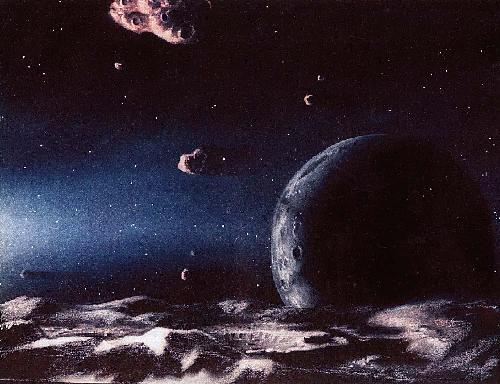
| SCATTERED KUIPER BELT OBJECTS (SKBOs) |
|---|
Some KBOs possess large, eccentric, inclined orbits that have perihelion distances near Neptune's orbit. The archetypal "Scattered Kuiper Belt Object" is 1996 TL66 , discovered as part of a 50 square degree survey using the University of Hawaii 2.2-m telescope on Mauna Kea. In February 1999, we discovered 3 more examples of SKBOs (1999 CV118, CY118 and CF119) in a deeper wide field survey undertaken with the Canada-France-Hawaii Telescope and a 12288x8192 pixel CCD. As our survey has progressed the number of SKBOs has risen dramatically, so that now we clearly see that that the SKBOs are a distinct dynamical population in the Kuiper Belt, separate from the Classical and Resonant objects. We expect that more SKBOs will be discovered as improved technology allows us to probe larger areas of the ecliptic sky to deeper limiting magnitudes.
Population
The 35 AU perihelion distances allow Neptune to exert weak dynamical control over the SKBOs. On billion year timescales, perihelic perturbations by Neptune will change the orbit parameters from their present values. The SKBOs form a fat doughnut around the Classical and Resonant KBOs, extending to large distances. There are presently 9 objects (excluding comets) with aphelia greater than 500 AU. Examples include 2000 OO67, which has an aphelion distance near 1250 AU and 2006 SQ372, with Q = 2140 AU. Eventually, much larger orbits will be found.
There is, however, an important bias against finding SKBOs with very large aphelion distances. Such objects spend only a small fraction of each orbit close enough to the sun to be detected in ground-based observational surveys. 1999 CF119, for example, would be undetectable in the survey in which it was discovered for more than 90% of each orbit. This is why large sky areas must be studied in order to find SKBOs. In fact, SKBOs account for only 3 to 4% of the known Kuiper Belt Objects but, because of observational bias, this is a strong lower limit to the abundance of these objects. A list of SKBOs (confusingly mixed in with the Centaurs) is maintained by the Minor Planet Center.
Origin
How did the SKBOs get their eccentric, looping orbits? Fernandez (1980) suggested that planetesimals might be scattered into this type of orbit in the early days of the solar system. KBOs that approach Neptune closely are generally scattered away on short (million year) timescales. Many are passed to the dynamical control of other planets, ultimately to be lost from the solar system by ejection or by absorption (collision with a planet or the sun). Planetesimals ejected into very large orbits either escape from the gravitational influence of the sun (and then enter the realm of interstellar space) or may be perturbed by the galactic tidal field and by passing stars into orbits in the Oort Cloud. Objects scattered to the few 100 AU aphelion distances seen in most SKBOs are immune to galactic and stellar tides, and so remain in a tightly bound swarm (the fat doughnut) surrounding the solar system. Numerical simulations of this process by Duncan and Levison (1997) and many others since show this process in operation.
Source of Short-Period Comets
The dynamical involvement with Neptune means that the SKBOs are a potential source of short-period comets. Occasional Neptune perturbations can deflect SKBOs to planet-crossing orbits. Some of these bodies may find their way to the inner solar system, where sublimation of embedded ices will lead to their classification as comets. In part because the SKBO population is very uncertain, the ratio of short-period comets delivered from the resonances to those from the scattered disk is highly uncertain.
Recent work by Volk and Malhotra (2009) suggests that the number of SKBOs estimated by observers is much smaller than needed if the scattered population is to be the source of the Jupiter family comets. Whether the surveys or the dynamical simulations (or both) are in error remains to be seen.
Papers About SKBOs
We have written three papers about SKBOs:
Luu et al. (1997) describes the discovery and significance of the first SKBO, 1996 TL66.
Luu and Jewitt (1998) presents the reflection spectrum of TL66.
Trujillo et al. (2000) updates our assessment of the SKBO population using results from the CFHT 12k survey.
 |
Kuiper Belt |
|---|
Last Update Aug 2009